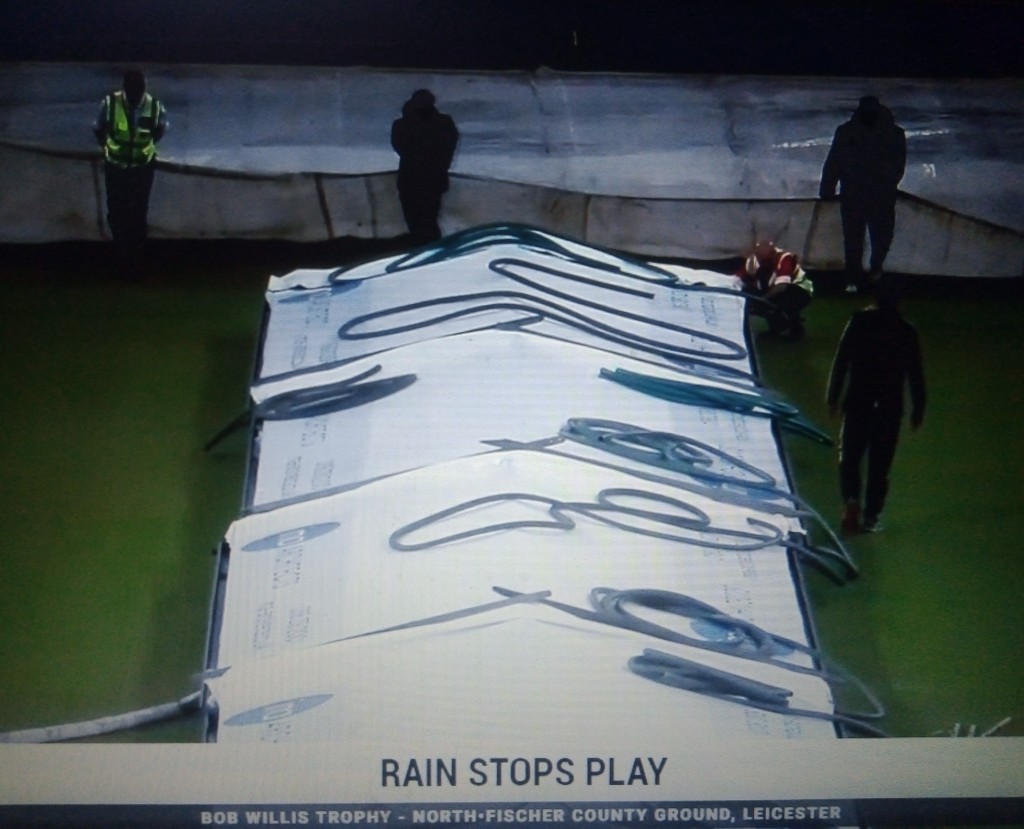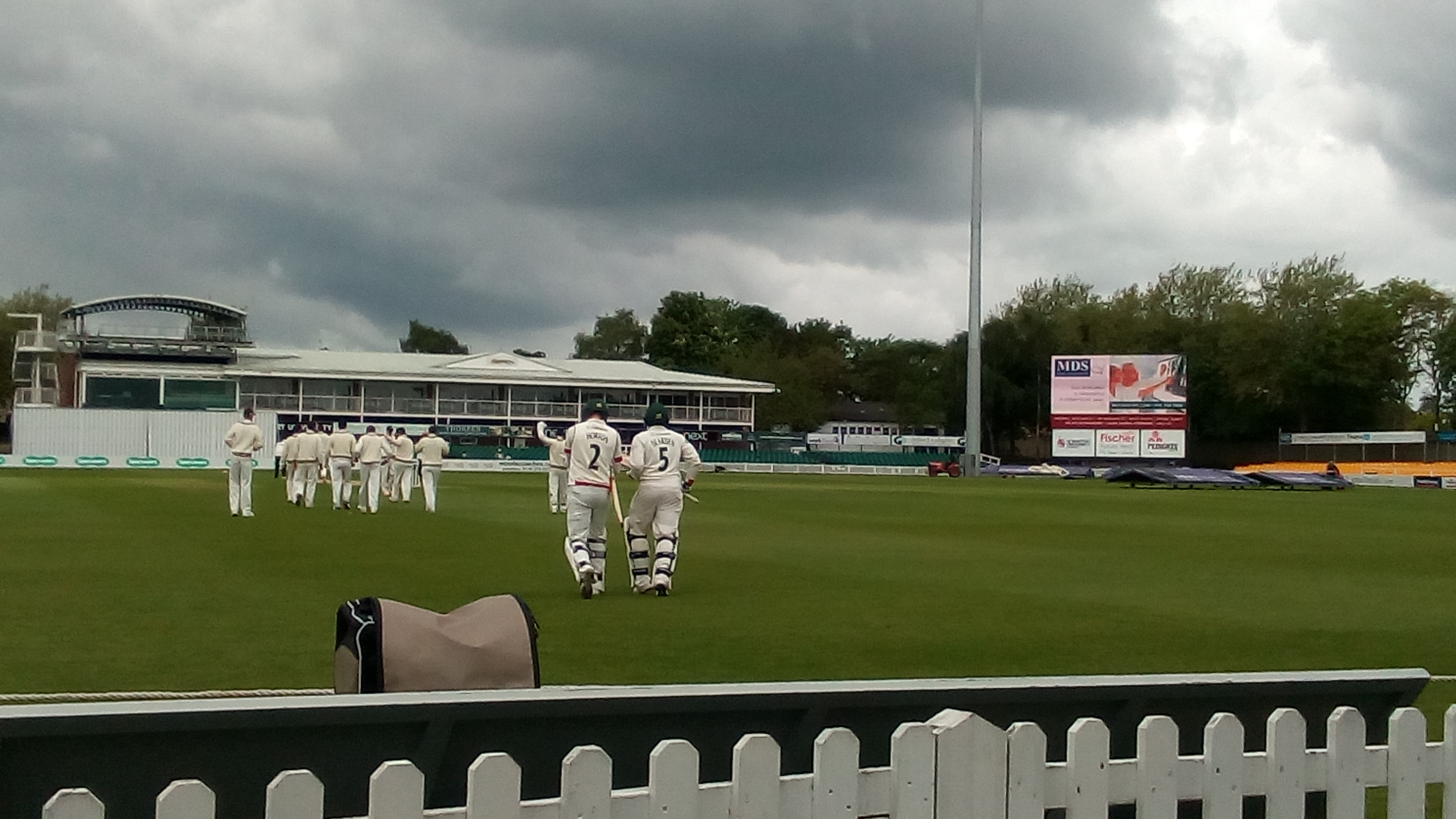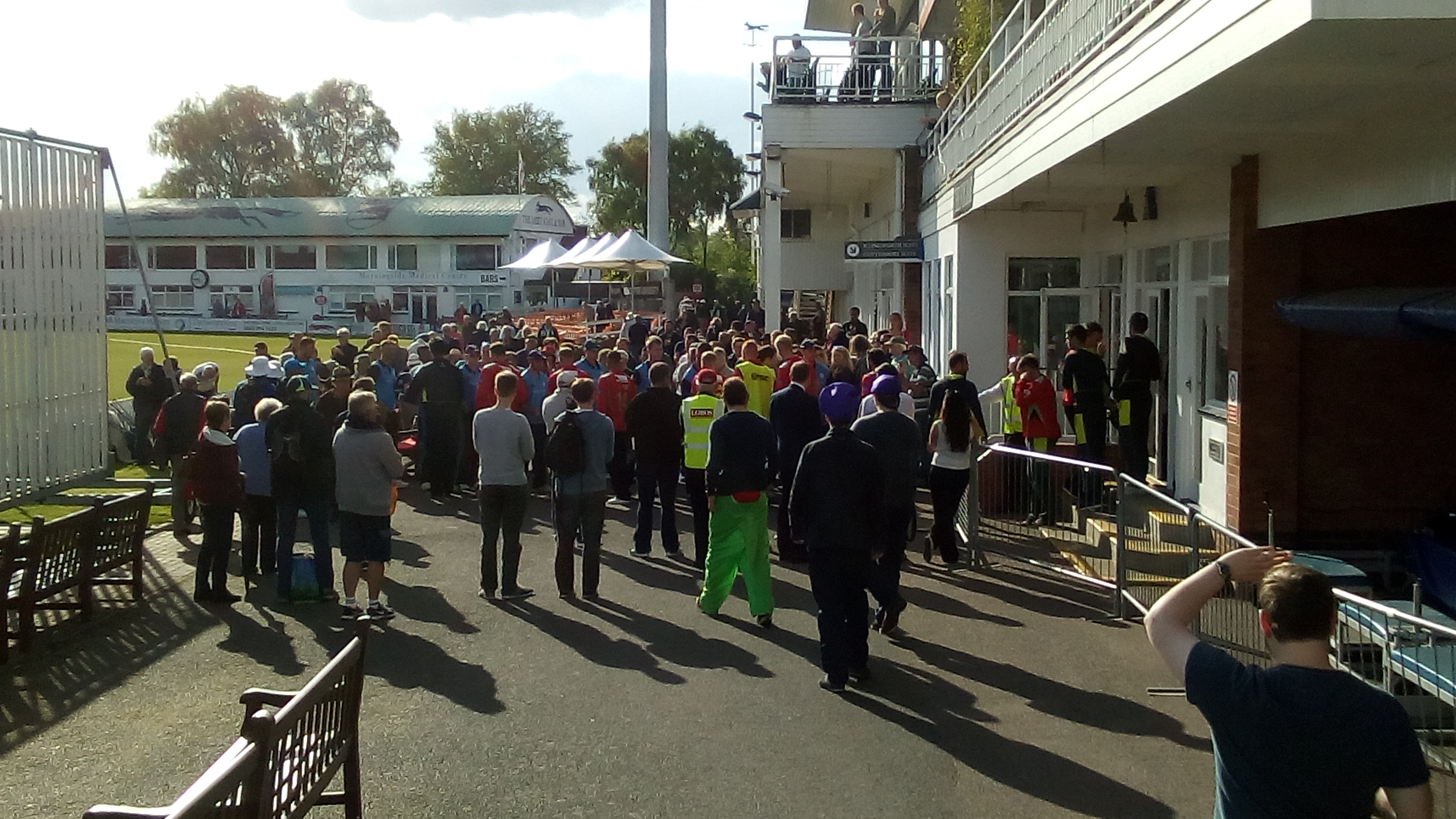
I generally sleep well these days. When I don’t, perhaps through an excess of wine or cheese, I sleep fitfully, slipping in and out of a series of dreams, caught up in narratives which cohere until I stir, when they dissolve, to be replaced by a succession of similar fragments, until I wake, when these mini-dramas, which temporarily compelled my attention, vanish from my memory. I mention this not to be gratuitously boring, but because following this year’s cricket season has seemed rather like that.
After months without cricket, it has felt like opening an overstuffed high cupboard in search of something lost, and having its contents fall out on to your head. Since I last wrote, I have followed (by various means), at a rough estimate, five Test Matches, four of Leicestershire’s Bob Willis Trophy games, three club matches at Market Harborough, four at Kibworth, one in Great Bowden, one on the Recreation Ground behind my home, and the closing stages of a junior game which I came across by accident on a walk.
Of these, I only saw one in its entirety, and in many cases that entirety was rendered less than entire by rain. At times, I have listened to one game in the morning and watched another in the afternoon ; at others, watched a County game online while listening to the Test on the radio. It is not surprising that most of them have, along with my fitful dreams, vanished from my memory. I suppose it is salutary to be reminded, by seeing a whole season concertinaed into a couple of months, how much of the average season is, far from the Platonic ideal as imagined by Neville Cardus, or me in the depths of Winter, spent in disappointment and wet frustration.
The structure of English cricket resembles a human pyramid : amazing feats are performed at its apex, while no-one notices that the bottom row are beginning to stagger, and that ill-wishers are attempting to kick their legs out from under them. To begin at the top of that pyramid, most of my memories of 2020’s international cricket will be of Test Match Special itself, rather than any of the games that they were reporting on. The interminable saga of what the presenters were planning to have for their dinner will be as redolent of the immediate post-lockdown period as the alcopop reek of hand-sanitiser, or wind-blown blue masks mingling with the early Autumn leaves.
TMS has been as much about itself as the cricket for years, and, in fairness, the numerous interruptions for rain did not leave much choice but to fall back on their own resources. Predictably, I found the dips into the archives the most memorable. What struck me (apart from how the presenters’ voices had deepened over the years), is how various those voices used to be : Arlott’s Hampshire ; Johnston and Blofeld’s music hall toff ; CMJ’s exaggerated RP ; Lewis’s Welsh ; Trueman and Mosey’s Yorkshire. With the departure of Boycott and Blofeld (who represented that tradition in, latterly, self-parodic fashion), we now hear, apart from Agnew (who will eventually turn into Johnston), and Vaughan’s trans-Pennine caw, the tones of Herne Hill, High Wycombe, Barnet, Dulwich and (with the addition of Mark Ramprakash), Bushey.
Perhaps cricket is now a less various game, perhaps we are a less variously-voiced nation (that portion of it that is allowed on the BBC, anyway), and TMS may well be the best programme that it is possible to produce in England in 2020. (I would not claim, incidentally, that my own tones, like Derek Nimmo on Mandrax*, would do anything to improve the situation). It goes without saying that I should miss TMS if it went, and that we should be grateful to the ECB, the West Indies and Pakistan for arranging two entertaining and coffer-replenishing series. So I shalln’t say it.
I am not the only one to have been dreaming. At first, I thought that naming this year’s County competition the ‘Bob Willis Trophy’ was a nicely sentimental tribute to the recently deceased great, if a little incongruous, given his reputed lack of enthusiasm for representing Warwickshire. But then I recalled his contribution to the symposium in the ‘Wisden Cricketer’ in October 1999, which I discussed at (probably excessive) length a short while ago.

In it, Willis, having accused the County members of having made ‘a terrible mess’ of running the game, and the players of being a ‘clapped-out army’, goes on to propose that we should ‘split our current 18 teams into three divisions of six and play ten first-class matches a season’. This is not quite what we have had this season, but, if various people who ought to know are to be believed, it is likely that we will be getting something along those lines next year. It is not obvious to me why this would be an improvement on previous arrangements, but, as most of the alternative proposals seem to involve Leicestershire ceasing to exist (as advanced by that frightful old ghoul Graves), or only playing limited overs cricket, it should not be much worse, given that it promises no reduction in first-class matches (thanks to some kind of subsidiary competition tacked on to the end of the main one).
Leicestershire’s results in the BWT have been a bonsai of one of their typical seasons : after their encouraging win against Lancashire in the first game, they lost by nine wickets to Derbyshire (having been forced to follow on, and – as the club’s Twitter put it – taken a slender 11 run lead) ; been denied by rain against Durham, in a contrived run chase they were favourites to win ; in their turn, denied Nottinghamshire a win in another game spavined by bad light and showers ; and, finally, a hugely discouraging ten wicket defeat by Yorkshire. I would like to say that I have followed all these faithfully on the streaming service, but it has been more a matter of a few afternoon sessions.
As compared to Lancashire’s coverage of the first game, which had fairly high production values, that from Grace Road has been a throwback to the earliest days of cricket broadcasting with a fixed camera at both ends (unless it was one bloke haring from end to end between overs on his bike). At times, the (fine) commentary has been a little ahead of the pictures, which at least alerts the viewer whose attention is wandering that a ball will be worth watching, and at others they have seemed to be employing some of the primitive psychedelic effects that used to feature on Top of the Pops in the early 1970s (though that was probably attributable to some inadequacy in my wi-fi connection). Given the rain we have had I seem to have spent a lot of the last months squinting at what appeared to be CCTV footage of the ground staff going about their business. At least we have been spared the vast boredom of replays and DRS reviews.

When play was possible, the fixed camera puts the viewer in the position of one who remains clamped to his seat behind the bowler’s arm, binoculars trained on the square. There are spectators of this kind in real life (what you might call the Ted Chippington tendency) and, no doubt, their diligence is rewarded by technical insights that those who, like me, prefer to roam around are denied. On the other hand, they miss a large part of what, for me, makes a day at Grace Road enjoyable : the susurrus overhead as the wind ruffles the limes, the creeping advance of the shade across the cheap seats parallel to the wicket as the afternoon draws on, the cheering sight of the lunchtime special being paraded from the kitchens to The Meet, the heady whiff of old socks and disinfectant issuing from the air conditioning in the indoor schools at the Bennett End. But I am becoming sentimental.
At least, except when they were having trouble focusing, the fixed cameras spared me the painful sight of what I was being denied. I have given up attempting to discern the logic behind the ever-changing restrictions, but I cannot understand why lower division football clubs are allowed to admit 10% of their capacity (the other evening I attended a game where the attendance was 230), when County cricket clubs are not allowed to admit any spectators at all, at grounds where the capacity is considerably larger. I would estimate the capacity of Grace Road to be about 10,000, so application of the same principle would mean that the number permitted to attend would be considerably in excess of any crowd we achieved for a Championship game last season. There do seem to have been some attempts to circumvent the lockout, including a suffragette-style chaining to the railings on the Milligan Road side, and an occupation of the balcony of the ‘Cricketers’ pub, which offers an unobstructed view of the pitch. At times the commentary could just pick up the plangent dying fall of Stench’s vuvuzela, summoning up remembrance of things past. But I am becoming sentimental again.
To look on the bright side, the freakish nature of the season has meant that none of the players has lost out too badly. Those who have been successful have advanced their cases, while those who have not can write their figures off as being too small a sample to be significant. Colin Ackermann has made a success of the captaincy, and has largely carried the batting. Harry Swindells has probably established himself as the first choice ‘keeper in red ball cricket. Sam Evans, with the bat, and Ben Mike, (mostly) with the ball, have done enough to remain ‘promising’ (though the latter promises more in the shorter forms). Harry Dearden is inching closer to averaging thirty in a season, has looked good when permitted to cut loose, and should be allowed to try it more often. Without doing anything startling, Tom Taylor has confirmed that the side is more balanced with him in it**. Callum Parkinson narrowly missed being our leading wicket-taker, and ought to play for often.
Heading the list of those who might prefer to write 2020 off as a bad dream is Hassan Azad, who, having made 58 in his first innings, made only another 86 in his next seven outings, averaging 18. Last September I expressed the fear that he could be in for a ‘a testing time next season’ : I could not have predicted quite how testing it would be for all of us, but I hope the cricket gods will accept this as his ‘difficult second season’. The rot set in against Derbyshire, with a couple of freakish dismissals : in the first he was stumped off a seamer, perhaps having already set off on his post-delivery stroll half way to square leg ; in the second, his logical scientific mind was unable to cope with the nonsensical questions (‘why is a hat stand an otter?’) posed by Leus du Plooy, a bowler whose stock delivery seemed to be the waist-high full toss. To add a comical irony to injury, he took a wicket, having been brought on as a joke bowler with the aim of gifting Durham runs to expedite a declaration, and nearly finished top of the bowling averages.
Hassan has signed a two year extension to his contract, which requires something of a leap of faith on both sides : on Leicestershire’s that he can overcome the limitations of his game and prove that his first season was more typical than his second, and on his that Leicestershire are going to be able to pay a living wage to a player who is unlikely ever to feature in white ball cricket. With his qualifications, he cannot, even in the current climate, be short of other options. Alternatively, another of Willis’s recommendations – that there should only be 24 full-time professionals, with the rest playing as amateurs – might suit his case.
As usual, various ex-Foxes have come back to haunt us (though we were spared a visitation by Darren Stevens) : one of the more dreamlike images, enhanced by the psychedelic effects on CCTV, was the sight of Ben Raine and Ned Eckersley batting together against us for Durham. Zak Chappell, too, was back with Nottinghamshire, having undergone a transformation from the slim-gilt youth who used to turn out for Market Harborough into a hulking brute whom you might expect to see appearing under some macabre alias in a professional wrestling bout. He seemed to have sacrificed a little speed for accuracy (Tom Barber, at the other end, supplied the woolly wildness) : although I feel contractually obliged to wish him ill, I am pleased to see that he took 15 wickets (15 more than last season) and – as significantly – played four consecutive games. I wish him well.

One of the more attractive features of the BWT is that the format stimulated the teams to make greater efforts than usual to achieve a win. One memorable image is of Chappell, desperate to continue chipping away at some admirably obdurate last ditch resistance by Leicestershire on the last day, replacing the stumps that Nick Cook (who seemed more inclined to warm his toes in the Umpire’s room) had recently uprooted (and getting a ticking-off for his Lèse-majesté). Chappell’s urgency may have stemmed from a desire to end Nottinghamshire’s lengthy stretch without a win, which now dates back to June 2018 (having probably had enough of that at Leicestershire, not to mention Market Harborough).
Harborough too had not won since June 2018, until, unlike Notts, they won the last game of the season, against Thorpe Arnold. This was only the 1st XI’s second home game of the season, the scheduled second, against Electricity Sports, having fallen foul of the Leicester lockdown (an additional source of pain in this area). After an hour, Harborough were 30-odd for 6, with clouds gathering and rain in the air. I am afraid to say, dear reader, that I decided to cut my losses and caught a bus to the other end of town to watch the football (where Harborough Town won 6-0). It had been so cold and wet at the game that I assumed the only question was whether Thorpe Arnold had had time to finish us off before the game was abandoned. In fact, we had, God knows how, made 80 and bowled them out for 67. You would think that, given that I had been present for most of their home defeats, I might have been entitled to witness their victory, but I suppose it serves me right (O me of little faith!).
My season is, I think, over now, but the season is not : if you happen to be a follower of T20, Somerset or Essex it is approaching its climax, and if you follow the England Women’s team it is just beginning. September is a poignant time for cricketers (I know this must be true, because I say it every year). That poignancy usually stems from an atavistic awareness of a long Summer season approaching its end, and is softened by the sure and certain hope that it will return again in the Spring. This year there has been no long Summer season, the emotions are more mixed, and less simply nameable, and my hope that the season will return is less sure and far from certain. However, Winter well, as far as you are able.
*For younger readers, Nimmo was an actor of the ‘60s and ‘70s, who specialised in playing clergymen, and also advertised Penguin biscuits. Mandrax was a hypnotic sedative, popular as a recreational drug in the counterculture.
**Since I wrote this, Taylor has signed for Northamptonshire. It’s enough to unbalance anyone, never mind the team.




































































